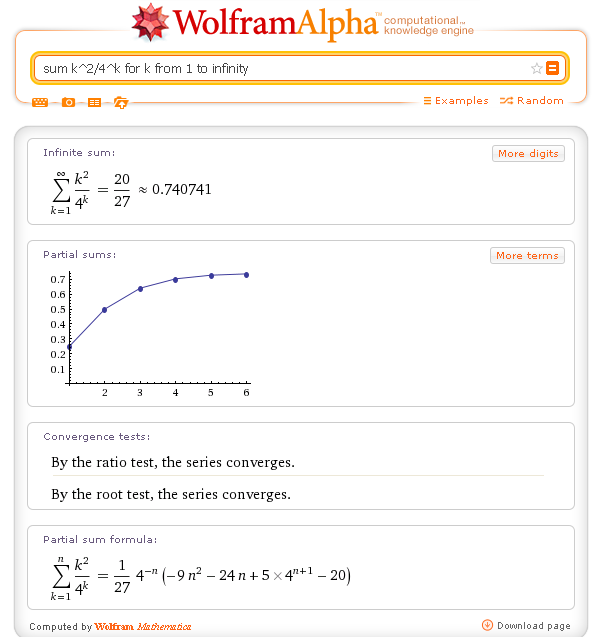Section 1.2 Infinite Series
In this section we will discuss the concepts and terminology associated with infinite series that we will need in order to discuss representing functions by infinite series.
An infinite series is a sum of the form
where \(t_k\) are (real) numbers.
We call \(t_1, t_1+t_2, t_1+t_2+t_3, \ldots\) the sequence of partial sums for the series.
Example 1.2.1.
Both of the following are infinite series:
The sum of a finite number of real \(x\) numbers is always finite. However, for an infinite sum, as we add more and more terms in the series the sum:
Might get closer and closer to some number. This is called convergence. For example
\begin{equation*} \sum_{k=1}^{\infty}\frac{1}{2^k}=\frac{1}{2^1}+\frac{1}{2^2}+\frac{1}{2^3}+\cdots = \frac{1}{2}+\frac{1}{4}+\frac{1}{8}+\cdots. \end{equation*}Sometimes a sum reaches a value and does not change (i.e. the terms become zero). We also call this convergence, e.g.\begin{equation*} \sum_{k=1}^{\infty}0 = 0+0+0+\cdots = 0. \end{equation*}Any other behaviour is called divergence. For example
\begin{equation*} \sum_{k=1}^{\infty}k = 1+2+3+\cdots \end{equation*}and\begin{equation*} \sum_{k=1}^{\infty}(-1)^{k-1}=(-1)^0+(-1)^1+(-1)^2+\cdots = 1-1+1-1+1-\cdots \end{equation*}(this last example is actually tricky to define properly).
On adding the first \(10\) terms of the series \(\displaystyle \sum_{k=1}^{\infty}\frac{1}{2^k}\) we get \(0.99902344\cdots\text{,}\) on adding the first \(20\) terms we get \(0.99999905\cdots\text{.}\) So even though as we add more terms the sum is getting larger it is getting closer and closer to some fixed number. Adding lots of terms of the series (as we did above) suggests that for this case the sum is converging to \(1\text{.}\) If this is the case (and we will show below that it is) then we would say:
The series converges to \(1\)
The sum of the series is \(1\)
The limit of the series is \(1\)
There is a lot of mathematics devoted to determining the nature of an infinite series. We will mention just three useful results.
Theorem 1.2.2. The Divergence Test.
If the terms \(t_k\) of the series \(\displaystyle \sum_{k=1}^{\infty}t_k\) do not approach \(0\) as \(k\to\infty\) then the series diverges.
Theorem 1.2.3. Geometric Progressions.
If the infinite series is a geometric progression (GP), i.e., of the form
then it converges if and only if \(|r|< 1\text{,}\) in which case it converges to
Theorem 1.2.4. The Ratio Test.
For the series \(\displaystyle \sum_{k=1}^{\infty}t_k\text{,}\) let \(\displaystyle L=\lim_{k\to \infty}\left|\dfrac{t_{k+1}}{t_k}\right|\text{.}\) If
\(L<1\) then the series converges
\(L>1\) then the series diverges
\(L=1\) then the test is inconclusive
Example 1.2.5.
Determine the nature of the series \(\displaystyle\sum_{k=1}^{\infty}k = 1+2+3+\cdots.\)
Example 1.2.6.
Determine the nature of the series
Example 1.2.7.
Determine the nature of the series
Convergent.
To use the ratio test consider
Thus
Since \(L<1\text{,}\) by the ratio test this series converges. (Notice that the ratio test doesn't tell us to what number the series converges to. In this case it is \(3\text{.}\))
We eventually want to represent a function via an infinite series. To do so the infinite series will have to involve a variable (the independent variable of the function). Clearly for an infinite series involving a variable the behaviour of the series will depend upon the value of the variable.
Example 1.2.8.
For which values of \(x\) will the following series converge?
\(-\dfrac{3}{2} < x < \dfrac{3}{2}\text{.}\)
Note that this is a GP with \(a=1\) and \(r=\dfrac{-2x}{3}\text{.}\) Thus the series will only converge for those values of \(x\) that satisfy \(\left|\dfrac{-2x}{3}\right| < 1 \text{,}\) that is, \(-\dfrac{3}{2} < x < \dfrac{3}{2}\text{.}\)
Just to check this, let \(x=1\text{.}\) Then the series becomes
which converges to \(S=\dfrac{1}{1+2/3}=\dfrac{3}{5}\text{.}\) Note that, on adding the first \(20\) terms of the series we get \(0.59981956\cdots\) and on adding the first \(50\) terms we get \(0.59999991\cdots\text{,}\) and so it does indeed seem that the sum is \(3/5\text{.}\)
Definition 1.2.9. Power Series.
A power series about \(a\) is an infinite series of the form
where the \(c_k\) are real numbers.
Example 1.2.10.
The series
is a power series about \(0\) (with \(c_k=1\) for all \(k\)). There are several points worth noting about this power series.
The series definitely converges when \(x = 0\text{.}\)
The series is a GP with \(a=1\) and \(r=x\) and so converges for \(|x|<1\text{.}\)
When the series converges it converges to \(S=\dfrac{1}{1-x}\text{.}\)
This last point is interesting because it is telling us that for \(f(x)=\dfrac{1}{1-x}\) if \(|x|<1\) we have
Example 1.2.11.
The series
is a power series about \(1\text{.}\) For this series
It definitely converges for \(x = 1\text{.}\)
-
It can be shown, via the ratio test, that the series converges for \(0 < x <2\text{.}\) Firstly,
\begin{equation*} L =\lim_{k\to\infty}\left|\dfrac{(x-1)^{k+1}}{k+2}\cdot\dfrac{k+1}{(x-1)^k}\right| = |x-1|. \end{equation*}Thus \(L<1\) when \(|x-1|<1\text{,}\) i.e., \(0 < x <2\text{.}\)
For example, with \(x=3/2\) adding the first \(20\) terms gives \(1.3862947\cdots\) while adding the first \(50\) terms gives \(1.3862943\cdots\text{.}\)
For \(0 < x <2\) we can think of this infinite series as defining a function, i.e.
\begin{equation*} f(x) = \sum_{k=0}^{\infty}\dfrac{(x-1)^k}{k+1}. \end{equation*}In which case, as we saw above, \(f(3/2)=1.3863\) to \(4\) d.p.
Remark 1.2.12.
Note that it can be shown that a power series about \(x=a\) either
Converges only for \(x=a\)
Converges for \(|x-a|<R\) and diverges for \(|x-a|>R\) (note what happens when \(|x-a|=R\) depends on the particular power series)
Converges for all \(x\)
The value of \(R\) is called the radius of convergence. In the first case we say \(R=0\) and in the third case we say \(R=\infty\text{.}\) The collection of those \(x\) for which the series converges is called the interval of convergence \(I\) of the power series.
Exercises Example Tasks
1.
Determine whether the following series converge or diverge. If the series is a convergent GP then find its sum.
\(\displaystyle \displaystyle \sum_{k=0}^{\infty}\dfrac{1}{3+2^{-k}}\)
\(\displaystyle \displaystyle \sum_{k=1}^{\infty}\dfrac{3}{10^{k}}\)
\(\displaystyle \displaystyle \sum_{k=1}^{\infty}\dfrac{k^3}{3^k}\)
\(\displaystyle \displaystyle \sum_{k=1}^{\infty}\dfrac{k}{k^2+4}\)
2.
Determine the interval of convergence for the following series.
\(\displaystyle \displaystyle \sum_{k=1}^{\infty}\dfrac{(3x-2)^k}{k\,3^k}\)
\(\displaystyle \displaystyle \sum_{k=1}^{\infty}(-1)^k\dfrac{x^{2k}}{(2k)!}\)
Remark 1.2.13. Aside.
Computer algebra systems usually have commands for summing infinite series. For example, with Wolfram Alpha you can just type in the first few terms as shown.

The following example shows another query to Wolfram Alpha and the associated output.
